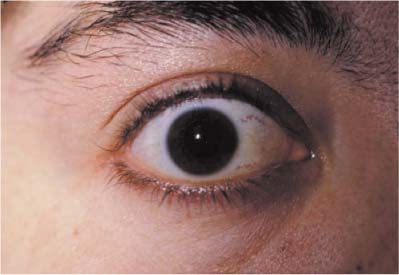Chapter 38 Thyroid-associated orbitopathy is the most common disorder of the orbit and the most common cause of proptosis in both adults and children. It can be mild and asymptomatic, or cause severe eye disease, with keratitis, strabismus, and irreversible visual loss secondary to optic nerve compression by enlarged extraocular muscles. Recognition of this condition is important, as treatment is available. A patient with thyroid-associated orbitopathy should be evaluated immediately if there is symptomatic visual loss. If the patient presents with diplopia and/or proptosis, evaluation should be performed within 1 to 2 weeks. Patients with thyroid-associated orbitopathy may present with any of the following symptoms. Patients may have binocular diplopia (horizontal, vertical, or oblique) from involvement of the extraocular muscles, or monocular diplopia from corneal surface changes. Both the upper and lower lids may be retracted; that is, the upper lid may be at or above the upper limbus, whereas the lower lid may be at or below the lower limbus. Patients may describe this as the eyes being “more open” or “staring.” Occasionally, when the retraction is unilateral, they believe that the abnormality is on the contralateral side and describe either a ptotic eyelid or an eye that is more closed. At initial presentation, thyroid-associated orbitopathy may manifest unilateral or bilateral proptosis. Some patients note that their eyes have become more prominent, whereas others become aware of the change only after family or friends have alerted them to the change. Patients with thyroid-associated orbitopathy may describe retrobulbar and/or periorbital discomfort. Some discomfort is due to keratitis, which is sometimes described as an ache, but more often as dryness or as a foreign-body sensation. There are, however, many patients with thyroid-associated orbitopathy who have no keratitis, or well-treated keratitis, but who still experience a mild-moderate discomfort of unclear etiology. Severe, sharp, or well-defined pain is rare. Patients with thyroid-associated orbitopathy may experience visual loss, which is usually subacute. Such patients may have already been diagnosed with systemic Graves’ and/or orbitopathy, or the visual loss may be the initial manifestation of the disease. Visual loss is due to either corneal involvement or optic nerve compression; both should be managed immediately. This may be secondary to keratitis or to a compressive optic neuropathy. Optic neuropathy should be suspected when there is decreased visual acuity, dyschromatopsia, and/or visual field defects. A relative afferent pupillary defect will be present if there is unilateral or asymmetric bilateral involvement, but not if there is symmetric bilateral disease. This is frequently seen and is due to the fact that the thickened muscles compress the globe more than normal ones do. It is often exacerbated in upgaze, due to tethering of the globe by the abnormal muscles. Thyroid-associated orbitopathy causes a restrictive strabismus, with positive forced-duction testing. The medial and inferior recti are the most commonly affected muscles; thus patients most commonly present with an esotropia and/or hypotropia. Any extraocular muscle can be affected, however, and any strabismus pattern can be seen. FORCED-DUCTION TESTING Forced-duction testing is used to differentiate restrictive strabismus from other motility disorders. A drop of topical anesthetic is instilled in the eye. A cotton-tipped applicator is soaked in 10% cocaine or other potent topic anesthetic, and placed on the muscle to be tested for approximately 1 minute. The anesthetized muscle is then grasped with toothed forceps and the eye is rotated in the direction away from the action of the muscle. For example, if a patient presents with an abduction deficit, to determine whether the deficit is a result of a tight medial rectus or a cranial nerve VI palsy, the medial rectus muscle should be grasped and rotated laterally. If resistance is encountered, a restrictive etiology is confirmed. The normal resting position of the upper lid is just below the upper limbus and that of the lower lid just above the inferior limbus. When proptosis is present with ipsilateral lid retraction, it is highly suggestive of thyroid-related orbitopathy (Fig. 38–1). In a small minority of patients lid retraction may not be evident because of concomitant myasthenia gravis causing ptosis. Lid lag can be elicited by having the patient follow a fixation target from extreme upgaze to extreme down-gaze, and noting lagging of the lid downward movement behind the globe’s downward movement. The examiner should not move the target too quickly, or it will be difficult to detect the lag. Lagophthalmos is the failure of the lids to cover the eye when closed. It is best assessed by asking patients to pretend that they are sleeping by gently closing the eyes.
THYROID-ASSOCIATED ORBITOPATHY (GRAVES’ DISEASE)
URGENCY OF EVALUATION
DIAGNOSIS
SYMPTOMS
Diplopia
Lid Retraction
Proptosis
Pain
Visual Loss
SIGNS
Visual Loss
Optic Neuropathy
Increased Intraocular Pressure
Ophthalmoplegia
Lid Retraction
Lid Lag (von Graefe’s Sign)
Lagophthalmos
Stay updated, free articles. Join our Telegram channel

Full access? Get Clinical Tree



